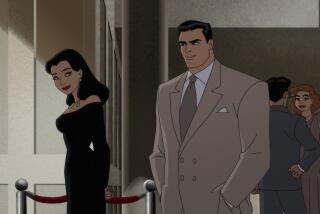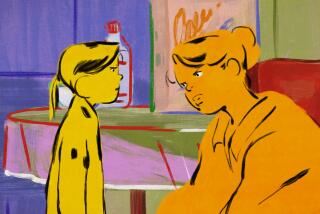Quasi-Adult Quasimodo : Disney’s ‘Hunchback’ Mixes Usual Kids’ Fluff With Grown-Up Side
- Share via
Like another famous tale set in Paris, Disney’s animated version of Victor Hugo’s venerable “The Hunchback of Notre Dame” is the best of times and, if not really the worst of times, something uncomfortably close to it.
Transforming a novel despairing enough to have previously attracted and challenged torment-oriented actors such as Lon Chaney and Charles Laughton into a story suitable for a company that’s made a fortune by making nice did not promise to be easy. So Disney turned the assignment over to producer Don Hahn and directors Gary Trousdale and Kirk Wise, responsible for the best of the modern animation epics, “Beauty and the Beast.”
And, though Hugo’s fatalistic story has been given the inevitable happy ending, “Hunchback” is in many ways the most satisfyingly dark and adult of the Disney versions. Its strongest aspects (aside from its remarkable visual flair) are things not usually associated with feature-length cartoons: a convincingly evil villain, a couple with a palpable physical attraction for each other and an impressive sequence dealing with the torments of (sorry, Walt) sexual lust.
The trouble is that this involving material does not coexist well with the film’s predictably fluffy aspects, its formulaic reliance on cute sidekicks and indifferent songs, a once-potent engine that began running out of steam with “Pocahontas” and shows no sign of recovering power here.
Also a problem is Quasimodo (voiced by Tom Hulce), one of the great grotesques of both literary and cinematic history, who has been turned by Disney’s team of five writers (Tab Murphy, Irene Mecchi, Bob Tzudiker & Noni White and Jonathan Roberts) into a Sensitive New Age Guy, cuddly enough to be called Quasi by his intimates, burdened not by severe deformity or deafness but by that curse of modern times, lack of self-esteem.
“Hunchback’s” prelude shows Quasi arriving in 15th century Paris as an infant and ending up the ward of the meanest man in the city, Claude Frollo. Hugo’s novel made Frollo an archdeacon of the church, but Disney, perhaps weary after several tussles with the religious right, has changed him to a secular judge.
Frollo parks Quasi in Notre Dame’s bell tower, where he’s so lonely his only companions are three stone gargoyles his imagination brings to life. Victor (Jason Alexander), Hugo (Charles Kimbrough) and Laverne (Mary Wickes) do nothing but smother the lad with advice until, convinced by them that “life is not a spectator sport,” Quasi ventures outside the cathedral and gets crowned King of the Fools for his trouble.
*
Once out of the tower, Quasi meets the Gypsy Esmeralda, who takes one look at our hero and says, “Great mask!” Still, Quasi is smitten, and, with Esmeralda (voiced by Demi Moore, sung by Heidi Mollenhauer) inspired more by Playboy’s cartoon Femlin than anything Hugo wrote, it’s no wonder.
While Esmeralda has her eye on the more suitable Capt. Phoebus (Kevin Kline), Quasi has had his head so turned by those well-meaning gargoyles he starts to see himself as a viable romantic rival. Quasi may not get the girl, but he does teach everyone in the audience about the need to tolerate differences and understand “what makes a monster, what makes a man.” He really does.
Conveying much of this predictable arc are the film’s standard-issue songs, with music by Alan Menken and lyrics by Stephen Schwartz. This pair first worked together on the unmemorable “Pocahontas,” and their collaboration seems even less inspired here. Even a reprise of “Colors of the Wind” would have been appreciated.
Much more exciting are “Hunchback’s” visuals. Having a story set in Paris has invigorated the animators, especially those who work with computer-generated images, and among the new twists they’ve come up with is a way to create believable crowd scenes involving thousands of people.
The imposing physical beauty of Notre Dame also proved inspirational, leading to several scenes where a swooping camera follows characters as they cavort around the elaborate and eccentric shapes of this celebrated structure.
*
And speaking of the physical, the sparks between Esmeralda and Capt. Phoebus are the most tangible and convincing of any recent Disney film, helped along by edgy verbal byplay. When, for instance, the Captain tells Esmeralda, “You fight almost as well as a man,” she snaps back, “I was going to say the same thing about you.”
The film’s most realistic character, however, is the evil Claude Frollo, who understandably reminded supervising animator Kathy Zielinski of Anthony Hopkins in “The Silence of the Lambs.” Perfectly voiced by veteran British actor Tony Jay, Frollo is completely believable as an instigator of murder and mayhem, capable of burning all Paris if it suits his whim.
Frollo is also the centerpiece of “Hunchback’s” most unexpected sequence, “Hellfire,” where the good judge writhes in the torments of an overwhelming physical desire for Esmeralda. It’s heartening to see animation used in ways that can’t be defined as cute, and it’ll be equally interesting to hear how parents explain this scene to curious tykes.
It’s understandable, given the place of honor toddlers have in the Disney economic equation, that the creators of “The Hunchback of Notre Dame” weren’t encouraged to make everything as grown-up as the film’s best sequences. But seeing what they’ve accomplished makes us wish the company would do an animated film with adults in mind. That would be something to see.
* MPAA rating: G. Times guidelines: an extended sequence on the torments of sexual lust.
(BEGIN TEXT OF INFOBOX / INFOGRAPHIC)
‘The Hunchback of Notre Dame’
Tom Hulce: Quasimodo
Demi Moore/Heidi Mollenhauer: Esmeralda
Tony Jay: Claude Frollo
Kevin Kline: Capt. Phoebus
Paul Kandel: Klopin
Jason Alexander: Hugo
Charles Kimbrough: Victor
Mary Wickes: Laverne
David Ogden Stiers: Archdeacon
Released by Walt Disney Pictures. Directors Gary Trousdale, Kirk Wise. Producer Don Hahn. Animation story Tab Murphy, from the novel by Victor Hugo. Screenplay Tab Murphy, Irene Mecchi, Bob Tzudiker & Noni White and Jonathan Roberts. Editor Ellen Keneshea. Music Alan Menken. Songs Alan Menken, Stephen Schwartz. Art director David Goetz. Running time: 1 hour, 36 minutes.
* In general release throughout Southern California.
More to Read
Only good movies
Get the Indie Focus newsletter, Mark Olsen's weekly guide to the world of cinema.
You may occasionally receive promotional content from the Los Angeles Times.








